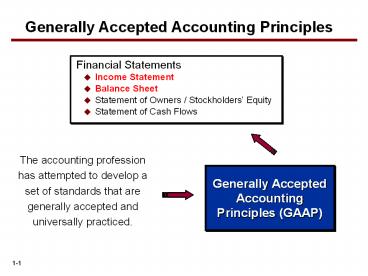Financial%20Accounting%20and%20Accounting%20Standards - PowerPoint PPT Presentation
Title:
Financial%20Accounting%20and%20Accounting%20Standards
Description:
The Basic Accounting Equation Illustration 1-6 Owners or Expenses are the cost of assets consumed or services used in the process of earning revenue. Common ... – PowerPoint PPT presentation
Number of Views:208
Avg rating:3.0/5.0
Title: Financial%20Accounting%20and%20Accounting%20Standards
1
Generally Accepted Accounting Principles
- Financial Statements
- Income Statement
- Balance Sheet
- Statement of Owners / Stockholders Equity
- Statement of Cash Flows
The accounting profession has attempted to
develop a set of standards that are generally
accepted and universally practiced.
Generally Accepted Accounting Principles (GAAP)
2
Generally Accepted Accounting Principles
Generally Accepted Accounting Principles (GAAP)
Standards that are generally accepted and
universally practiced. These standards indicate
how to report economic events.
- Standard-setting bodies determine these
guidelines - Securities and Exchange Commission (SEC)
- Financial Accounting Standards Board (FASB)
- International Accounting Standards Board (IASB)
3
Some Generally Accepted Accounting Principles
Economic Entity requires business activities be
kept separate and distinct from the activities of
its owner personal activities and all other
economic entities.
Cost Principle dictates that companies record
assets at their cost.
4
Forms of Business Ownership
Proprietorship
- Generally owned by one person.
- Often small service-type businesses
- Owner receives any profits, suffers any losses,
personally liable for all debts.
5
Forms of Business Ownership
Partnership
Proprietorship
- Generally owned by one person.
- Often small service-type businesses
- Owner receives any profits, suffers any losses,
and is personally liable for all debts.
- Owned by two or more persons.
- Often retail or service businesses
- Generally unlimited personal liability
6
Forms of Business Ownership
Partnership
Corporation
Proprietorship
- Ownership divided into shares of stock
- Separate legal entity organized under state
corporation law - Limited liability
- Generally owned by one person.
- Often small service-type businesses
- Owner receives any profits, suffers any losses,
and is personally liable for all debts.
- Owned by two or more persons.
- Often retail and service-type businesses
- Generally unlimited personal liability
- Partnership agreement
7
Balance Sheet
Corporation
Proprietorship
Partnership
Owners Equity Capital Withdrawal
Owners Equity Capital
Withdrawal (Separate Capital and Withdrawal
accounts ones for EACH partner)
Stockholders Equity Paid-In Capital
Retained Earnings Dividends
Common Stock
8
The Basic Accounting Equation
Assets
Liabilities
Owners Equity or (Stockholders Equity)
Assets
- Resources a business owns.
- Provide future services or benefits.
- Cash, Supplies, Equipment, etc.
9
The Basic Accounting Equation
Assets
Liabilities
Owners Equity or (Stockholders Equity)
Liabilities
- Claims against assets (debts and obligations).
- Creditors - party to whom money is owed.
- Accounts payable, Notes payable, etc.
10
The Basic Accounting Equation
Assets
Liabilities
Owners Equity or (Stockholders Equity)
Stockholders Equity
- Ownership claim on total assets.
- Referred to as residual equity.
- Common stock (Paid-In-Capital) and Retained
Earnings.
11
The Basic Accounting Equation
Illustration 1-6
Owners or
Revenues result from business activities entered
into for the purpose of earning income. Common
sources of revenue are sales, fees, services,
commissions, interest, dividends, royalties, and
rent.
12
The Basic Accounting Equation
Illustration 1-6
Owners or
Expenses are the cost of assets consumed or
services used in the process of earning
revenue. Common expenses are salaries expense,
rent expense, utilities expense, tax expense, etc.
13
The Basic Accounting Equation
Illustration 1-6
Dividends a distribution of cash (or other
assets) to owners. Dividends reduce retained
earnings. However, dividends are not an expense.































